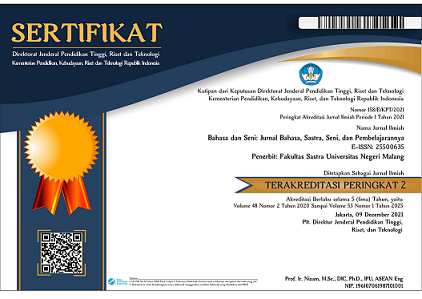Improving students’ interest in music subject through practical learning in junior high school
Abstract
Improving students’ interest in music subject through practical learning in junior high school
This research aims to investigate problems and ways to increase students’ interest in music learning with practical learning methods. This study uses descriptive qualitative and quantitative (mixed) methods. Data were collected by means of questionnaires, observations and interviews. They were then analyzed by calculating the presentation of the success of the actions in this study. Indicator analysis consists of several aspects, including affective data (attitudes) obtained from observations, cognitive (knowledge) obtained from the students’ assessment, and the questionnaire analysis of the research sample. Researchers took a research sample at one of the schools in Jakarta. Then the researchers randomly selected 15 students from different classes in the school as research participants. The results showed that practical learning could increase students’ interest by 87% in category A with a very satisfying indexation when compared to the previous method applied by most teachers, the classical learning method.
Keywords: practice learning, students’ interest, music learning, music education
Meningkatkan minat belajar musik siswa melalui pembelajaran praktek di SMP
Penelitian ini bertujuan untuk mengkaji masalah dan berupaya untuk meningkatkan minat belajar musik siswa dengan metode pembelajaran praktek. Penelitian ini menggunakan metode deskriptif kualitatif dan kuantitatif (campuran). Pengumpulan data dilakukan dengan kuesioner, observasi, dan wawancara. Pengumpulan data tersebut kemudian dianalisis dengan menghitung penyajian keberhasilan tindakan dalam penelitian ini. Analisis indikator terdiri dari aspek data afektif (sikap) yang diperoleh dari observasi dan aspek kognitif (pengetahuan) yang diperoleh dari penilaian siswa, serta hasil analisis angket sampel penelitian. Peneliti mengambil sampel penelitian di salah satu sekolah di Jakarta. Kemudian peneliti memilih secara acak 15 siswa dari kelas yang berbeda di sekolah tersebut sebagai objek penelitian. Hasil penelitian menunjukkan bahwa pembelajaran praktik dapat meningkatkan minat siswa sebesar 87% pada kategori A dengan indeksasi yang sangat memuaskan dibandingkan metode sebelumnya yang diterapkan oleh sebagian besar guru, yaitu metode pembelajaran klasikal.
Kata kunci: pembelajaran praktek, minat siswa, pembelajaran musik, pendidikan musik
Full Text:
PDFReferences
Bartolome, S. J. (2013). Growing through service: Exploring the impact of a service-learning experience on preservice educators. Journal of Music Teacher Education, 23(1), 79-91. https://doi.org/10.1177/1057083712471951
Bennett, E., & Heaton, P. (2012). Is talent in autism spectrum disorders associated with a specific cognitive and behavioural phenotype? Journal of Autism and Developmental Disorders, 42(12), 2739-2753. https://doi.org/10.1007/s10803-012-1533-9
Bowman, W. (2002). Educating musically. In R. Colwell & C. Richardson (Eds.), The new handbook of research on music teaching and learning (pp. 63-84). Oxford University Press.
Dansereau, D. R. (2015). Young children’s interactions with sound-producing objects. Journal of Research in Music Education. https://doi.org/10.1177/0022429415574001
Daryanto. (2010). Belajar dan mengajar. Yrama Widya.
Gie, T. L. (1995). Cara belajar yang efisien. Liberty.
Hamalik, O. (1992). Psikologi belajar dan mengajar. Sinar Baru.
Harrop – Allin, S. (2010). Recruiting learner’s musical games as resources for South African music education, using a multiliteracies approach. University of the Witwatersrand, Johannesburg, South Africa.
Herdiati, D., & Saputra, D. N. (2021). Mapping constraints of art extracurricular in Indonesia as an effort of policy design. Harmonia: Journal of Arts Research and Education, 21(1), 140-153. https://doi.org/10.15294/harmonia.v21i1.26480
Hietanen, L., Ruokonen, I., Ruismäki, H., & Enbuska, J. (2016). Student teachers’ guided autonomous learning: Challenges and possibilities in music education. Procedia - Social and Behavioral Sciences. https://doi.org/10.1016/j.sbspro.2016.02.080
Jamalus. (1988). Pengajaran musik melalui pengalaman musik. Depdikbud.
Jazuli, M. (2008). Paradigma kontekstual pendidikan seni. Unesa University Press.
Mappiare, A. (1982). Psikologi remaja. Usaha Nasional.
Moleong, L. J. (2000). Metodologi penelitian kualitatif. Rosda Karya.
Peñalba, A., Martínez-Álvarez, L., & Schiavio, A. (2021). The active musical room: Fostering sensorimotor discoveries and musical creativity in toddlers. Journal of Research in Music Education. https://doi.org/10.1177/0022429420953062
Rusman (2010). Model-model pembelajaran: Mengembangkan profesionalisme guru. PT Raja Grafindo Persada.
Salvador, K., & Corbett, K. (2016). “But I never thought I’d teach the little kids”: Secondary teachers and early-grades music instruction. Music Educators Journal, 103(1), 55-63. https://doi.org/10.1177%2F0027432116655199
Salvador, K., & Pasiali, V. (2017). Intersections between music education and music therapy: Education reform, arts education, exceptionality, and policy at the local level. Arts Education Policy Review, 118(2), 93-103. https://doi.org/10.1080/10632913.2015.1060553
Saputra, D. N. (2020a). Effort to improve elementary students interest on music subject with “learning by doing” method class. ADI Journal on Recent Innovation (AJRI). https://doi.org/10.34306/ajri.v2i2.74
Saputra, D. N. (2020b). New curriculum: The concept of freedom learning in music learning in Department of Music Education. https://doi.org/10.31098/ictase.v1i1.15
Surya, H. (2003). Kiat mengatasi kesulitan belajar. Gramedia.
Tomlinson, M. M. (2012). Transformative music invention: Interpretive redesign through music dialogue in classroom practices. Australian Journal of Music Education, 1, 42-56.
Wiggins, J. H., & Espeland, M. (2012). Creating in music learning contexts. In G. E. McPherson & G. F. Welch (Eds.), The Oxford handbook of music education (Vol. 1., pp. 341-360). London, Oxford University Press.
Yoni, A. (2010). Menyusun penelitian tindakan kelas. Familia.
Young, S. (2010). Musicality. In J. C. E. Gillen & A. Cameron (Eds.), International perspectives on early childhood research: A Day in the life (pp. 59-76). Palgrave Macmillan.
DOI: http://dx.doi.org/10.17977/um015v49i22021p167
Refbacks
- There are currently no refbacks.

This work is licensed under a Creative Commons Attribution 4.0 International License.

Dear Sir/Madam
We appreciate your continued confidence and trust in Bahasa dan Seni: Jurnal Bahasa, Sastra, Seni, dan Pengajarannya (JBS). In order to enhance the service, readability, and quality of JBS publications, we will be transitioning to a new website, https://citeus.um.ac.id/jbs, in collaboration with Digital Commons (Elsevier) starting in July 2024.
Sincerely
Yusuf Hanafi
(Editor in chief)
















2.png)